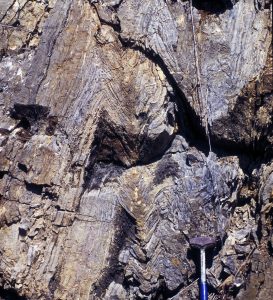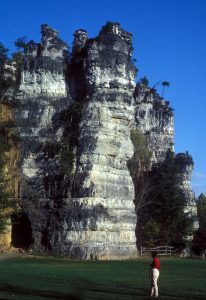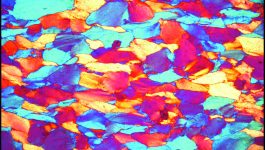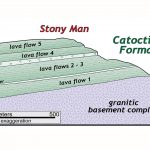The Valley & Ridge province consists of elongate parallel ridges and valleys that are underlain by folded Paleozoic sedimentary rocks. The characteristic topography of this region results from differential erosion of linear belts of rocks that are repeated by folding and faulting. Rivers draining the Valley & Ridge province typically display a trellis drainage pattern.
The oldest sedimentary layers in the Valley & Ridge are Cambrian (~520 Ma) and the youngest are Carboniferous (~300 Ma). A thick sequence of primarily carbonate rocks underlies the Great Valley (known as the Shenandoah Valley in central and northern Virginia), these rocks were deposited in a shallow tropical ocean along the southeastern margin of ancient North America (Laurentia). Well-developed karst topography is characteristic of the Great Valley, and many caverns are located in the subsurface.
By late Ordovician (~450 Ma), clastic sediments were shed from distant highlands marking the onset of the Taconic orogeny. The Taconic orogeny and later tectonic events uplifted mountains to the east (in the Piedmont). Late Ordovician and Silurian rocks of the Valley & Ridge record the uplift and subsequent erosion of these ancient mountains. By the late Silurian carbonates were again being deposited in this region. Deposition of sediments continued from the Silurian through the Carboniferous in the Appalachian foreland basin (i.e. the Valley & Ridge and Appalachian Plateau) and record pulses of uplift & mountain building to the east. Continental collision in the late Paleozoic produced a fold and thrust belt in which Paleozoic sedimentary rocks of the Valley & Ridge were folded and transported westward along thrust faults. The Great Valley is underlain by a two-tier duplex in which the entire Cambrian and Ordovician rock sequence is repeated. Between 40 and 70% crustal shortening occurred in western Virginia during the late Paleozoic deformation event known as the Alleghanian orogeny.




